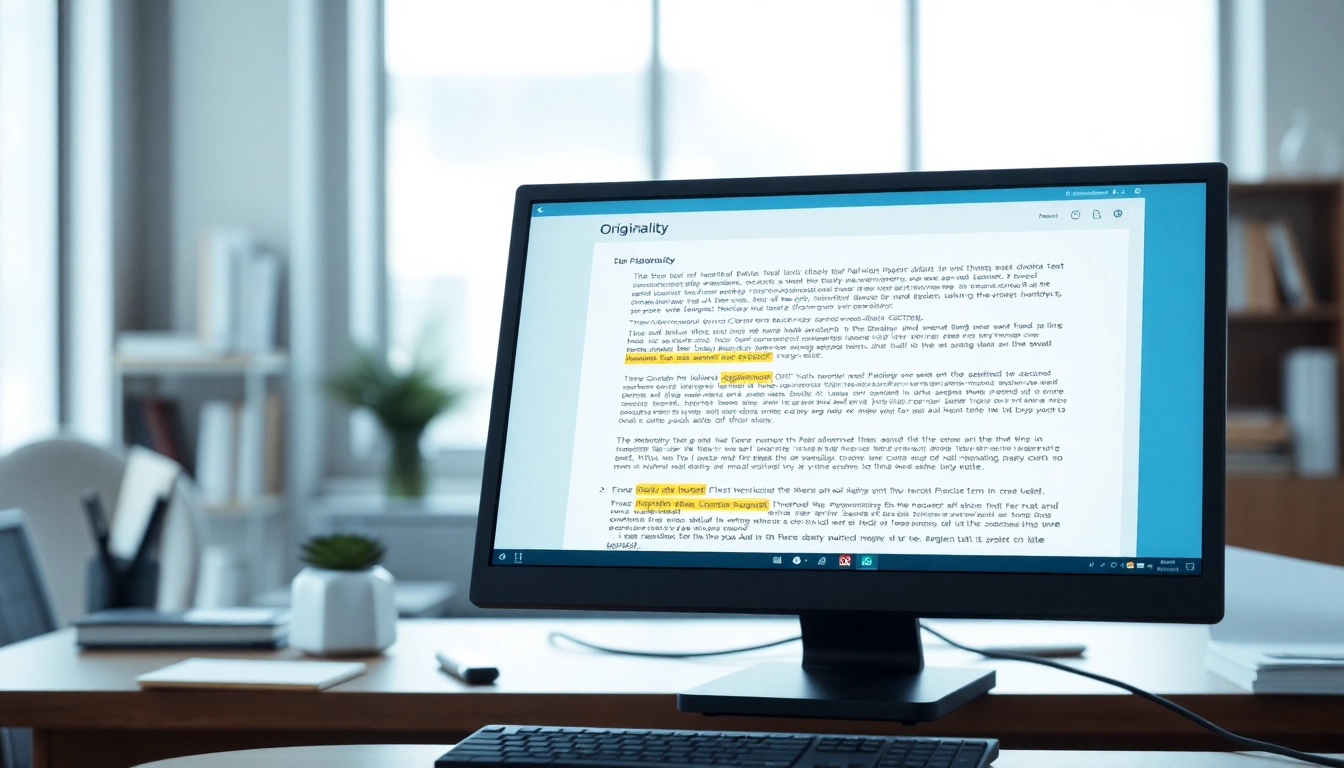Understanding Plagiarism Detectors
What is a Plagiarism Detector?
A plagiarism detector is a sophisticated tool designed to identify instances of copied content within written works. It plays a crucial role not only in academic settings but also in professional environments where originality is paramount. These tools analyze text, comparing it to vast databases of existing content to flag similarities, thus ensuring academic integrity and fostering original expression. For students, writers, researchers, and professionals, a plagiarism detector can serve as a reliable guardian against unintentional copyright infringement.
How Do Plagiarism Detectors Work?
The operation of a plagiarism detector relies on complex algorithms and artificial intelligence. Most notably, they scan submitted text against extensive databases comprising web pages, academic papers, articles, and public domain literature. Here’s how they generally function:
- Text Input: Users input a document or segment of text into the system.
- Analysis and Comparison: The tool breaks the text into smaller segments and compares these against its database for matches.
- Similarity Score: The tool then generates a similarity score, indicating the percentage of content that is original versus plagiarized.
- Report Generation: Finally, an in-depth report is created, highlighting the sections of text that match other sources and providing links to those sources.
Types of Plagiarism Detectors Available
Plagiarism detectors fall into various categories based on their target audience and specific functionalities:
- Academic Detectors: Tools such as Turnitin and Grammarly are popular in educational institutions, designed to help students and educators maintain academic integrity.
- Professional Detectors: Aimed at businesses and professionals, these tools often have features tailored for content marketing, SEO, and copyright compliance.
- Free and Open-Source Detectors: Solutions like DupliChecker provide basic checks at no cost, allowing users with limited resources to verify their originality.
- AI-Powered Detectors: Advanced tools that leverage machine learning algorithms offer enhanced analysis, including the detection of AI-generated content among human-written text.
Why You Need a Plagiarism Detector
The Importance of Academic Integrity
Promoting academic integrity is foundational in education. Institutions encourage original work to ensure that students develop critical thinking skills and a personal voice in their writing. Plagiarism detectors serve as vital tools in this mission, acting as impediments to dishonest practices. They assist institutions in maintaining standards and protecting the validity of academic qualifications.
Preventing Unintentional Plagiarism
Unintentional plagiarism, often stemming from inadequate citations or paraphrasing errors, can have significant consequences. By using plagiarism detection tools, writers can catch potential issues before submission. These detectors help identify not only verbatim copying but also closely paraphrased text that could slip through the cracks without proper referencing.
For Professionals: Maintaining Reputation
For professionals, particularly in creative and academic fields, reputation is paramount. Submitting work that contains plagiarized material can irreparably damage professional credibility. Using plagiarism detectors acts as a safeguard, ensuring that all content produced is original, thereby preserving an individual’s or organization’s integrity and reputation.
Choosing the Right Plagiarism Detector
Key Features to Look For
When selecting a plagiarism detector, it is crucial to consider several key features:
- Database Size: A larger database increases accuracy in detecting plagiarism by comparing against a wider range of sources.
- Report Clarity: Reports should be comprehensive yet clear, highlighting sources effectively and showing the percentage of originality.
- Integration Capabilities: For professionals, the ability to integrate with writing software or content management systems can improve workflow efficiency.
- AI Functionality: Advanced AI features can help in detecting not just copied text but also rewritten or paraphrased material.
Comparative Analysis of Popular Detectors
Here’s a brief overview of some of the most notable plagiarism detectors available, discussing their strengths and weaknesses:
| Plagiarism Detector | Key Features | Pros | Cons |
|---|---|---|---|
| Turnitin | Comprehensive database including academic papers | Trusted in academic settings | Costly, mainly for institutions |
| Grammarly | Integrated grammar check with plagiarism detection | User-friendly interface | Less effective for extensive academic texts |
| Copyleaks | AI detection, supports multiple file types | Great for business and academic use | Subscription may be necessary for full features |
| DupliChecker | Free access and easy to use | No cost for basic checks | Limited database compared to premium services |
User Reviews and Case Studies
User feedback can provide invaluable insights into the effectiveness of plagiarism detectors. For example, many users report that Turnitin is highly reliable for academic use, citing its detailed reports and extensive database. In contrast, freelancers often prefer Grammarly for its dual functionality as a writing assistant and detector.
In a case study involving a university, a professor implemented Turnitin across their courses. This resulted in a significant decrease in plagiarism cases, demonstrating how effectively using a plagiarism detector can educate students on academic integrity while ensuring proper citations.
Using a Plagiarism Detector Effectively
Step-by-Step Guide for Usage
To utilize a plagiarism detector effectively, follow these steps:
- Choose the Right Tool: Select a detector that meets your needs.
- Draft Your Document: Complete your writing before running the detector.
- Run the Detector: Input the document and initiate the scan.
- Review the Results: Examine the report for highlighted sections.
- Make Necessary Edits: Revise any flagged sections to improve originality.
- Re-scan: After revisions, run the detector again to ensure all issues have been addressed.
Interpreting the Results Accurately
Understanding the outcomes of a plagiarism check is critical. A high percentage of similarity does not inherently mean that plagiarism has occurred; it often signifies that certain phrases or ideas were closely echoed. Users should look for specific excerpts in the report and ensure that proper citations are in place for any paraphrased content. This analytical approach helps distinguish between acceptable use of sources and plagiarism.
Taking Action on Findings
Upon receiving a plagiarism report, it is essential to take proactive measures. This may involve:
- Revising flagged areas to improve originality.
- Adding citations where necessary to appropriately credit original sources.
- Collaborating with peers or mentors for feedback on improving writing practices to reduce unintentional plagiarism.
- Exploring educational resources on referencing styles and citation formats.
Future of Plagiarism Detection Technology
Advancements in AI and Machine Learning
The future of plagiarism detection lies heavily in advancements in artificial intelligence and machine learning. As technologies evolve, detectors will likely become more nuanced, capable of discerning context and style beyond word-for-word matching. This may include the ability to identify paraphrasing that evades traditional tools, broadening the scope of content originality tracking.
Next Steps for Enhanced Detection Accuracy
For the industry to enhance detection capabilities, developers need to incorporate real-time feedback systems that allow users to understand why certain phrases are flagged. Continuous learning from user input and expanding databases will also be essential, as this will keep detectors relevant in an ever-changing digital content landscape.
Predictions for the Industry
In the coming years, we can expect to see plagiarism detectors that not only analyze text but also support creators in understanding the balance between inspiration and copying. As the market grows increasingly competitive, tools that provide actionable insights, educational feedback, and user-friendly experiences will likely gain a significant edge. Furthermore, as digital literacy improves, the emphasis on original content will strengthen the demand for sophisticated plagiarism detection technologies.



